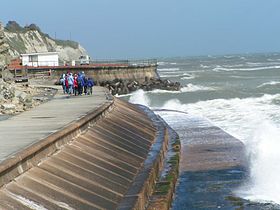
Back جدار التسونامي Arabic دیوار دریایی Persian Tembok laut ID 防潮堤 Japanese 방조제 Korean Zeedijk Dutch Opaska brzegowa Polish Противонагонная дамба Russian Sea wall SIMPLE கடல் சுவர் Tamil



A seawall (or sea wall) is a form of coastal defense constructed where the sea, and associated coastal processes, impact directly upon the landforms of the coast. The purpose of a seawall is to protect areas of human habitation, conservation, and leisure activities from the action of tides, waves, or tsunamis.[1] As a seawall is a static feature, it will conflict with the dynamic nature of the coast and impede the exchange of sediment between land and sea.[2]
Seawall designs factor in local climate, coastal position, wave regime (determined by wave characteristics and effectors), and value (morphological characteristics) of landform. Seawalls are hard engineering shore-based structures that protect the coast from erosion. Various environmental issues may arise from the construction of a seawall, including the disruption of sediment movement and transport patterns.[3] Combined with a high construction cost, this has led to increasing use of other soft engineering coastal management options such as beach replenishment.
Seawalls are constructed from various materials, most commonly reinforced concrete, boulders, steel, or gabions. Other possible construction materials include vinyl, wood, aluminum, fiberglass composite, and biodegradable sandbags made of jute and coir.[4] In the UK, seawall also refers to an earthen bank used to create a polder, or a dike construction. The type of material used for construction is hypothesized to affect the settlement of coastal organisms, although the precise mechanism has yet to be identified.[5]
- ^ Kamphuis, W J. (2010) Introduction to Coastal Engineering and Management. World Scientific Publishing Co Ltd. Singapore.
- ^ Shipman, Brian; Stojanovic, Tim (2007), "Facts, Fictions, and Failures of Integrated Coastal Zone Management in Europe", Coastal Management, 35 (2–3): 375–398, Bibcode:2007CoasM..35..375S, doi:10.1080/08920750601169659, S2CID 153826622
- ^ Kraus, N & McDougal. (1996) The Effects of Seawalls on the Beach: Part I: An Updated Literature Review in Journal of Coastal Research. Vol. 12, No. 3.
- ^ Clarke, J R. 1994. Integrated Management of Coastal Zones. Fao Corporate Document Repository, USA.
- ^ Hsiung AR, Tan WT, Loke LHL, Firth LB and others (2020) Little evidence that lowering the pH of concrete supports greater biodiversity on tropical and temperate seawalls. Mar Ecol Prog Ser 656:193-205